Featuring images collected in collaboration with Editor Dale Niesen of the Facebook group “The Image Collector” and other sources, reviewed by Jeff Stockham.
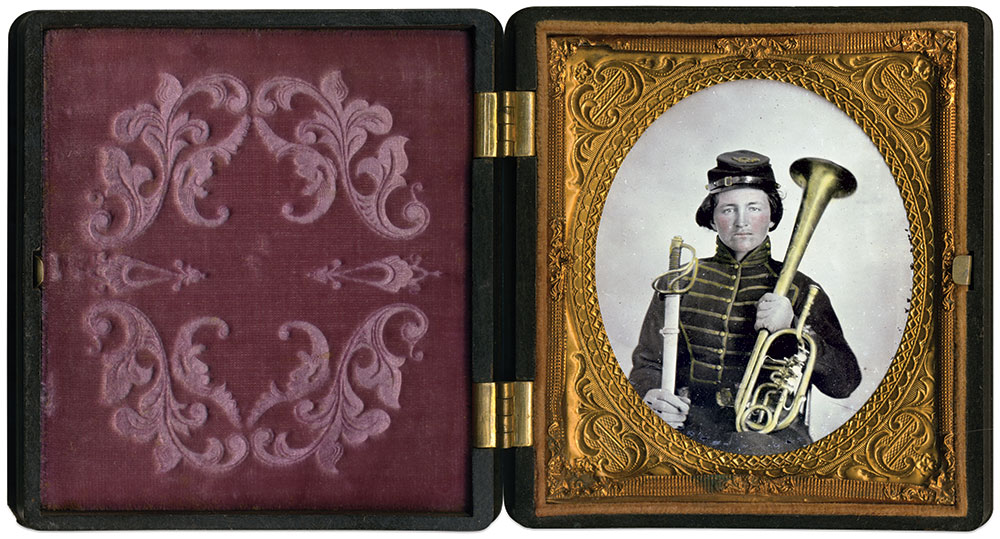
This Union musician holds an over-the-shoulder tenor saxhorn in one hand and a cavalry saber in the other. His cap features the hunting horn insignia of the federal infantry.
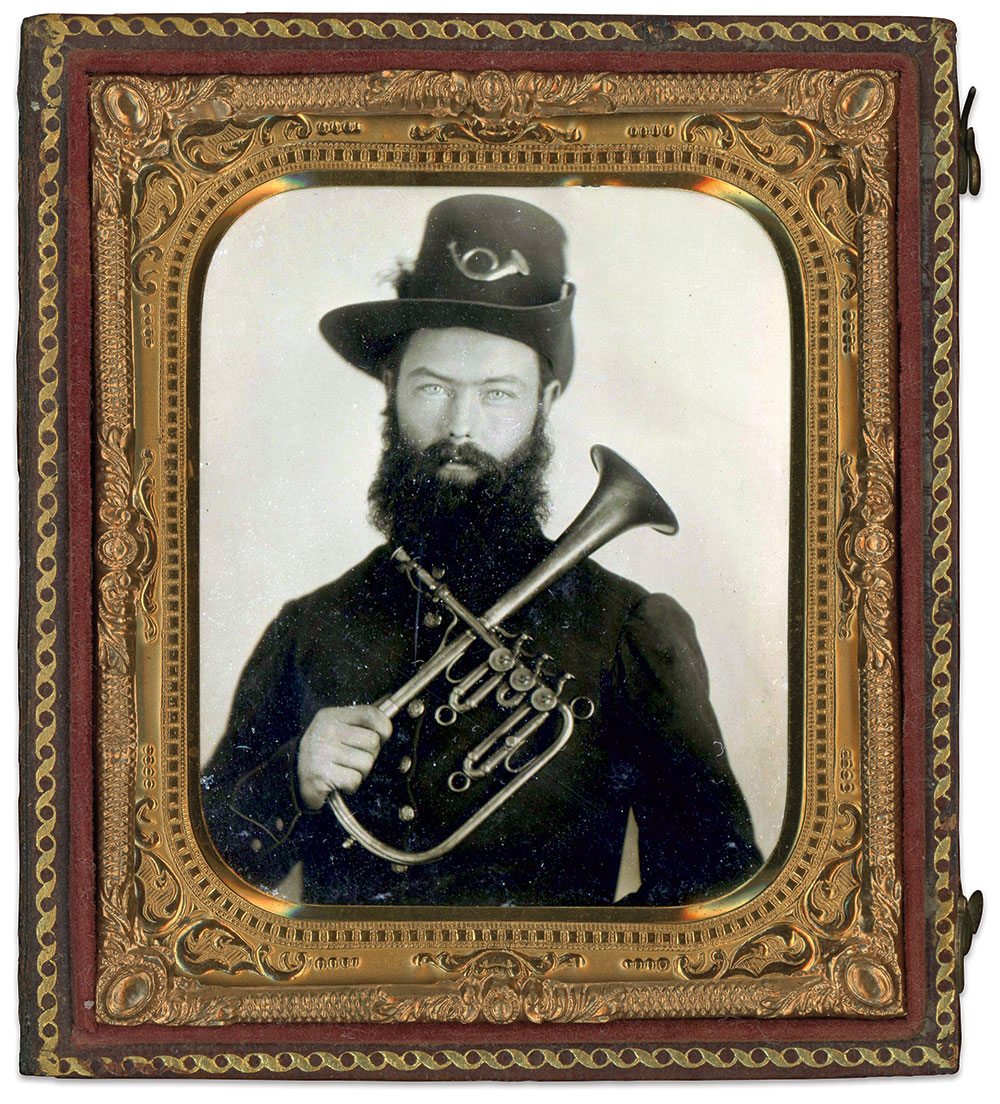
The way this infantry musician clutches his E-flat upright soprano saxhorn to his chest is reminiscent of how a soldier in the ranks might hold a revolver.
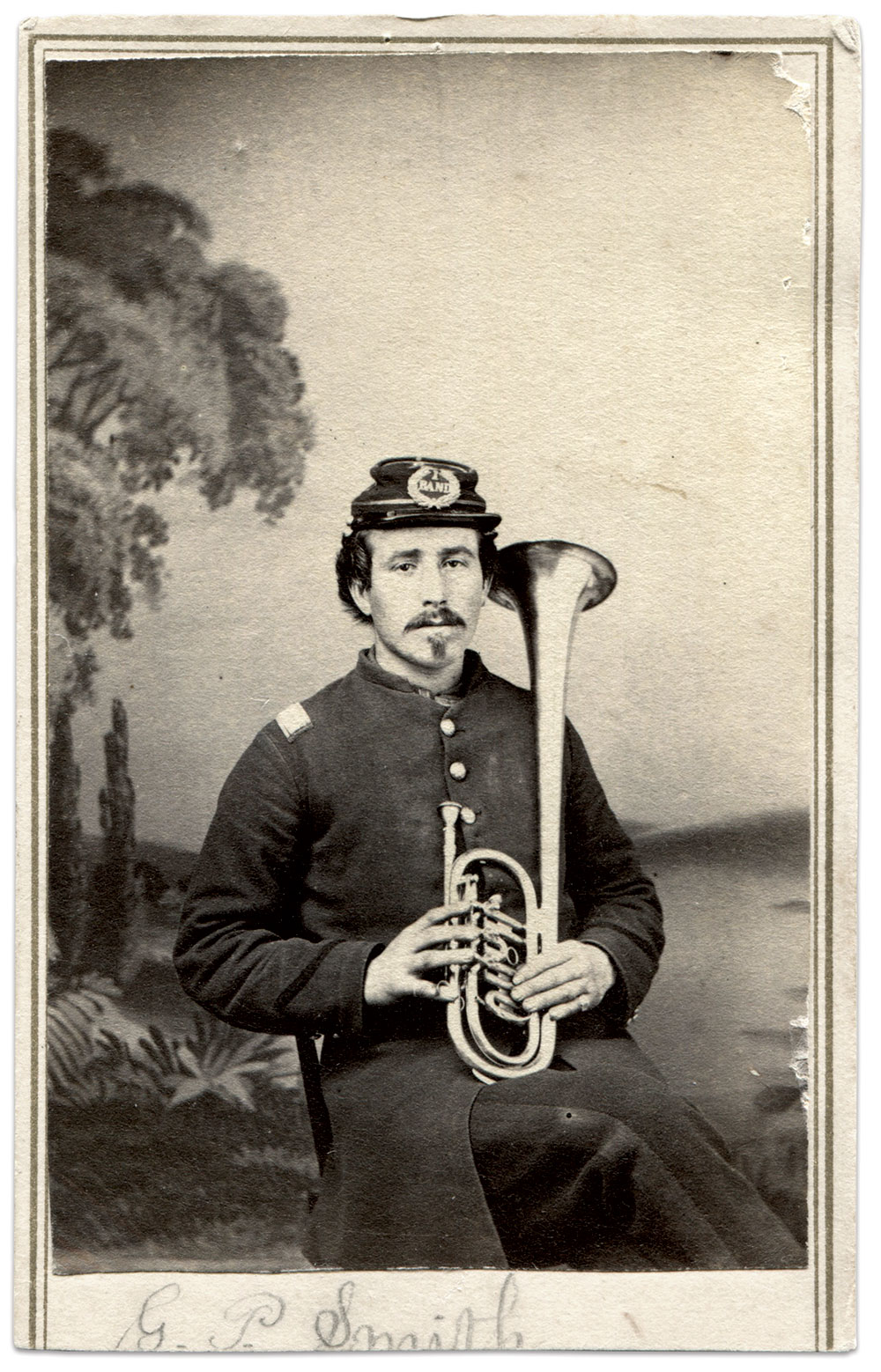
Many heavy artillery regiments in the East were called away from relatively comfortable duties off the front lines to participate in the 1864 Overland Campaign in Virginia. One of them, the 1st Maine Heavy Artillery, suffered heavy casualties at Cold Harbor, and elsewhere leading up to the fall of Petersburg and Richmond.
The regiment’s band included Maine-born Gilman Plastaid Smith, posed here with an E-flat over-the-shoulder alto saxhorn with Allen valves by Allen & Hall, or D.C. Hall, of Boston. Of note is his cap, marked with a wreath surrounding “1 Band.”
Smith survived his war experience, mustered out in June 1865, and returned to Maine. He sold shoes and boots to earn his living in Harrington and Bangor and remained active in the Grand Army of the Republic until his death in 1914 at age 68. He outlived his first wife, Bessie, and was survived by his second wife, Delia, and three children from his first marriage.

The gold gilded tuba in the hands of this musician is technically an E-flat over-the-shoulder bass saxhorn. During the war years, musicians in and out of uniform commonly referred to this instrument as an E-flat bass saxhorn rather than a tuba.
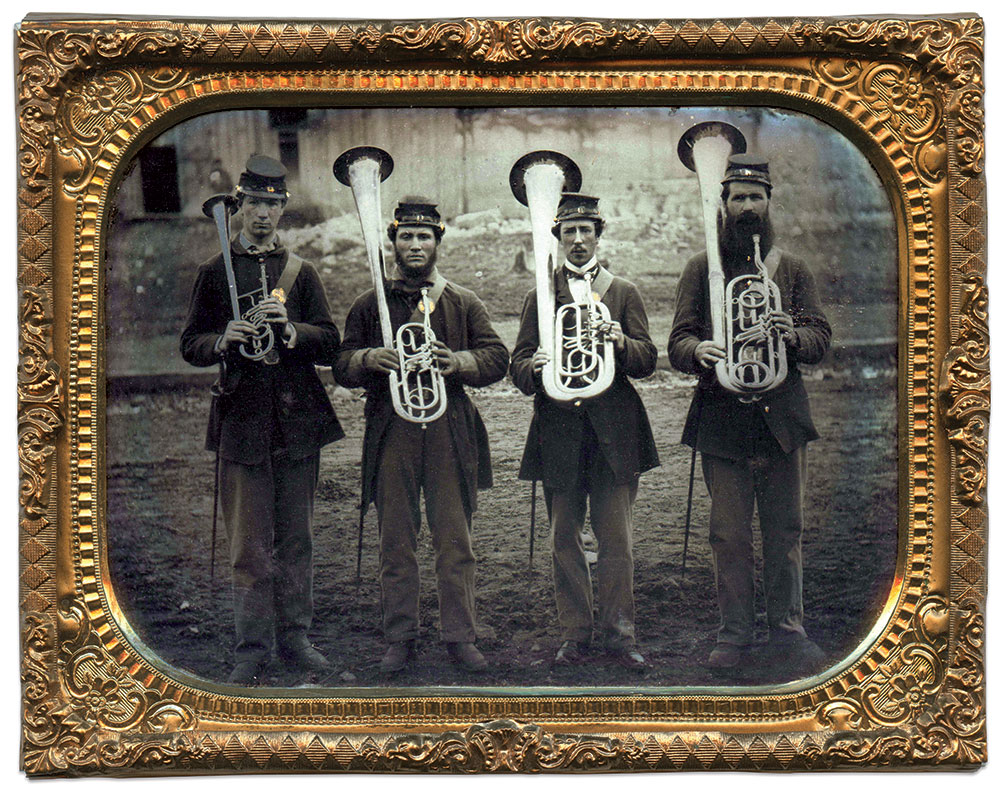
The 17-strong band of the 33rd Illinois Infantry served for about a year, from August 1861 until the summer of 1862, when the U.S. Congress abolished regimental bands due to the expense. Pictured here are four of its members posed with over-the-shoulder horns. The bandsman on the left, Prussian-born Karl Wilhelm Graen, also known as Charles Green (1840-1912), holds a B-flat soprano saxhorn (cornet). The unidentified bandsman next to him stands with a B-flat baritone saxhorn of European make. The next two men pose with European-made E-flat bass saxhorns: George Alexander Lowman (1838-1913) and an unnamed soldier.

This E-flat over-the-shoulder soprano saxhorn is held by a musician dressed in a frock coat with militia waist buckle and a cap trimmed with a stripe above the band.

The alto saxhorn cradled by this cavalry musician is of the upright variety rather than the over the shoulder model more commonly pictured in soldier portraits. In upright saxhorns, the bell directs the sound up instead of back. This model is a top-action-rotary-valve E-flat alto saxhorn. The maker is indeterminate but may have been produced by John F. Stratton of New York City.

A Veteran Reserve Corps musician poses with his E-flat over-the-shoulder soprano saxhorn made by John F. Stratton of New York City.

Dressed in a nine-button shell jacket with distinctive cuff trim, this saxhorn player rests his forearm on an over-the-shoulder B-flat tenor model possibly made or imported by Klemm & Brother of Philadelphia, Pa. Dents on the tube suggest it has weathered hard service. A modern pencil inscription on the back states “M.G. McGriff.”

Fortress Monroe served as both a training ground and headquarters for the 3rd Pennsylvania Heavy Artillery from early 1863 through the end of the war. The oversized regiment had its own band, and it included Jacob Eppley Shettel of the Keystone State’s Cumberland County. He is pictured here with his over-the-shoulder alto saxhorn, possibly made by Charles A. Zoebisch of New York City. Zoebisch, a major music retailer and comptroller of the Moravian Church of America, played a key role in the survival of the church during the war era.
Shettel spent his three-year enlistment at Fortress Monroe. According to The Union Army, “from this point detachments were sent out, both by land and sea, to serve in any arm of the service and wherever troops were needed.” Assignments included service on army gunboats, the battles of Gettysburg and Fort Fisher, and the surrender of the Army of Northern Virginia at Appomattox.
Shettel mustered out in October 1865 and returned to live a farmer’s life in Cumberland County. He died at age 84 in 1921. He outlived his wife, Ellen, by one month. Two of his four children survived him.

This musician posed with an over-the-shoulder E-flat alto saxhorn by an unknown maker, entertained members of the Winchester City Boomerangs. His shako, featuring a pompon, federal eagle and militia company initials surrounded by a wreath, sits on top of a document—possibly sheet music. Organized in Winchester, Va., the Boomerangs became Company H of the state’s 13th Infantry. The regiment spent most of its service with the Army of Northern Virginia.
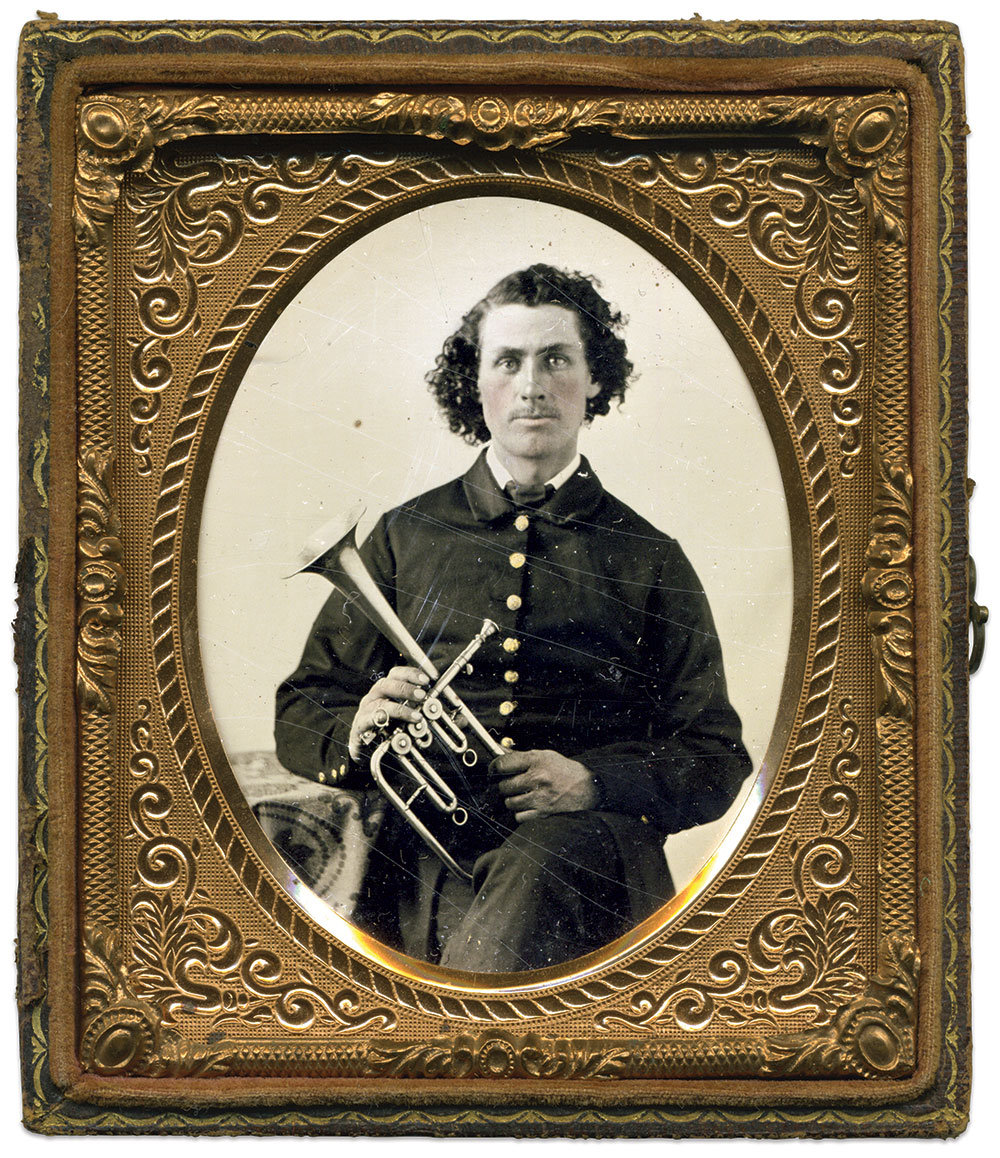
of American Photography.
Resting his fingers on the valves of an E-flat upright-bell soprano saxhorn, this musician appears ready to perform for the photographer.

The band of the 7th Veteran Reserve Corps included this musician armed with a top-action-rotary-valve (TARV) B-flat cornet with a bell front. The maker is indeterminate.

Jeremiah Sanford Potter started his Civil War service in June 1861 as a drummer in the 2nd Rhode Island Infantry. At the First Battle of Bull Run, he and his comrades marched at the head of the column led by Col. Ambrose E. Burnside The 2nd suffered about 114 casualties in the fight. Potter managed to escape unharmed but lost his drum. A year later, he advanced to drum major and poses here with a German-made slide trombone in B-flat. Note the trimmed cuffs, cording and shoulder knots on his uniform coat.
The Rhode Islanders served much of their four-year enlistment in the Army of the Potomac and fought in most of its major battles.
In peacetime, Potter lived and worked in Providence, R.I., as a jeweler and machinist until his death in 1909 at age 79. He outlived his wife, Mary, and was survived by four children.

A group of Union soldiers pose in camp surrounded by tree stumps, an ax, leather goods and a tent with a barrel smokestack. The soldier on the left, dressed in a four-button sack coat and a civilian hat, holds a B-flat cornopean, a horn with circular tube. It is also known as a Stölzel-valve cornet or cornet á piston. The maker is indeterminate.

An E-flat upright soprano saxhorn is cradled by this bearded musician.

The 13th Massachusetts Infantry’s band posed for this group portrait at Hagerstown, Md., during the first winter of the war. The musicians, members of the peacetime Marlboro Cornet Band, had enlisted in June 1861. A month later, the U.S. War Department issued General Order No. 48, which specified a band of 16-18 musicians per regiment. The order also allowed for two field musicians per company, to include buglers, fifers, and drummers. In August 1862, the government abolished regimental bands due to the expense.
This group of 17, 16 musicians and the bandmaster, pose with cornets, saxhorns, and drums—typical band instrumentation. All the men are identified. Standing, left to right: Bandmaster Thomas C. Richardson, Edward E. Bond, Stephen A. Howe, Silas B. Ball, Charles F. Witherbee, Charles H. Williams, Elbridge Lane, Foster W. Gassett, James B. Fuller, Austin B. Lawrence, and William R. Witherbee. Seated, from left to right: Francis W. “Frank” Knapp, William G. Howe, John M. Holt, John Brown and Frank W. Loring.

A militiaman sits with his family and an over the shoulder saxhorn. His uniform suggests a pre-war date: A Model 1851 shako with an eagle and wreath surrounding the three-letter initials of his company, non-regulation officer’s epaulettes and trimmed collar. His instrument, a B-flat tenor saxhorn with Allen valves, was produced either by J. Lathrop Allen, D.C. Hall, or Allen & Hall, all of Boston, Mass.

Cradling a B-flat over-the-shoulder soprano saxhorn, this musician wears a uniform with thick trim on the cuffs, decorative shoulder straps and a patent leather belt with light-colored edging. His cap insignia features a wreath surrounding an emblem of indeterminate origin.
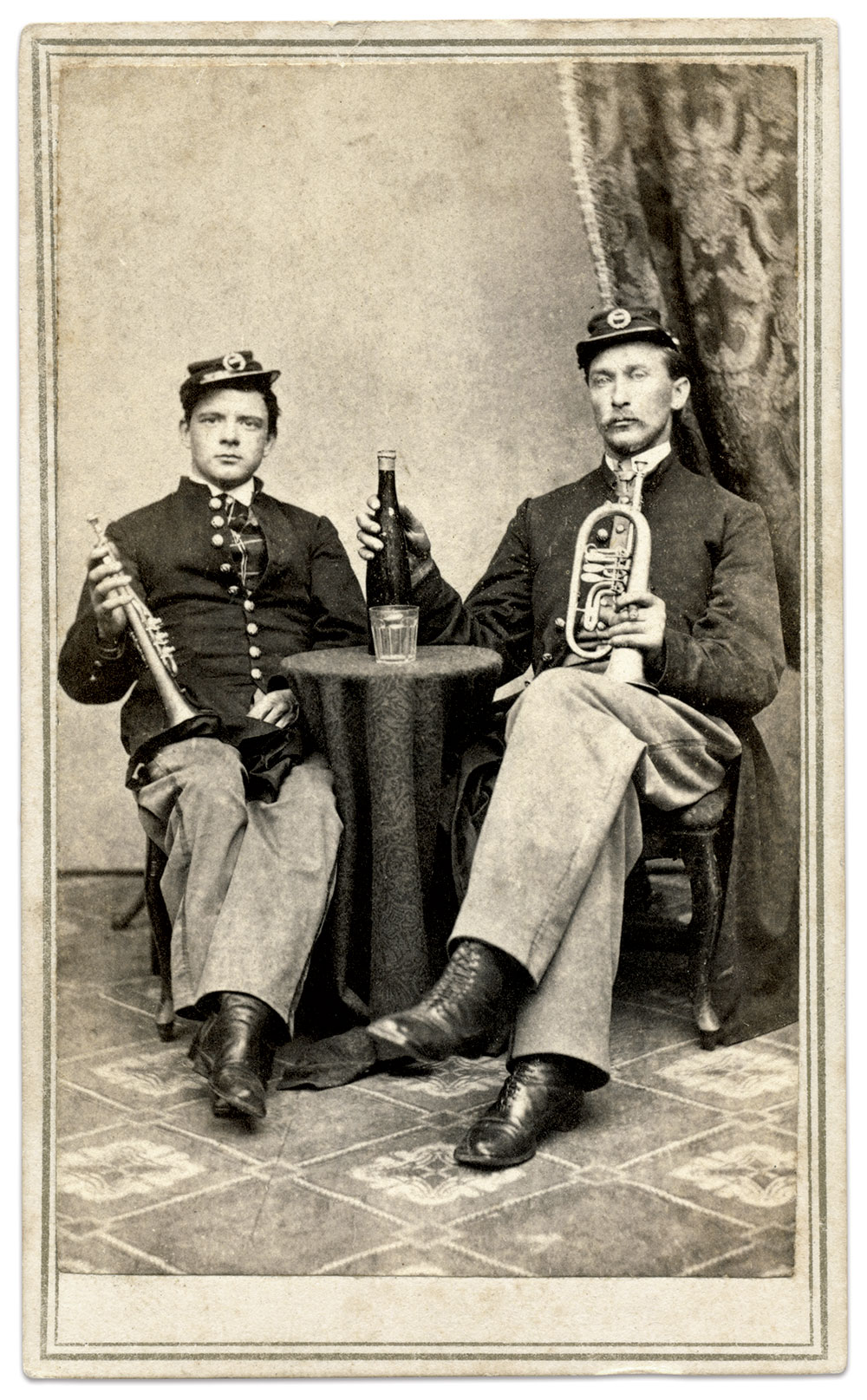
The warm, soft, rounder sound emanating from these cornets may have been even warmer after the players consumed the contents of the bottle on the table. The musician on the left is pictured with a B-flat side-action-rotary-valve (SARV) bell-front cornet by indeterminate maker. His bottle-wielding pard holds an E-flat SARV bell-front cornet, possibly manufactured by Elbridge G. Wright of Boston. This image was part of a group of portraits of members of the post band at Gallop’s Island in Boston Harbor. These men may have been attached to the 13th Veteran Reserve Corps.

In October 1861, Chief Musician Joseph C. Greene and the 4th Rhode Island Infantry band performed at the funeral of Col. Edward D. “Ned” Baker, who lost his life in the recent Battle of Ball’s Bluff. The bandsmen pictured here may have performed at the somber ceremony. The musician on the right holds an E-flat over-the-shoulder soprano saxhorn. His comrade grips an instrument as distinctive as the band’s uniforms: a B-flat over-the-shoulder soprano saxhorn with a unique rotary valve design made by Thomas Paine of Woonsocket, R.I.
The band’s history predates its Civil War service. Organized by Greene in 1825, it became formally known in 1837 as the “American Band and Orchestra of Providence, RI,” or simply the American Brass Band.
By the start of the Civil War, Greene and his players enjoyed a popular following throughout New England. The band brought its expertise into play with the 1st Rhode Island Detached Militia for a three-month tour of duty. The 1st participated in the First Battle of Bull Run. Later that summer, Greene organized a band for the 4th. Its membership included Canadian citizen Calixa Lavallée, who wrote, in 1880, “O, Canada,” which became the country’s national anthem a century later.
In August 1862, the band fell victim to army cost-cutting efforts to eliminate expenses and mustered out.

Principal Musician Thaddeus F. St. John of the 9th New York Cavalry stands with his European-made E-flat over-the-shoulder soprano saxhorn with clock-spring rotary valves. He carries a Model 1840 dragoon saber, likely manufactured before the war by W.H. Horstmann & Sons of Philadelphia. Note the shoulder belt for his saber, and his waist belt secured by an Ames-made Pattern 1851 buckle with a three-piece applied wreath variant. Tucked into this belt is a .31 caliber Model 1849 Pocket Revolver, and dangling below it is a watch key attached to a ribbon. He wears a first sergeant’s chevrons and lozenge–non-standard insignia for a musician.
St. John, of LeRoy, N.Y., joined the army in October 1861 and within two weeks of his enlistment rose to become his regiment’s chief musician. His tenure ended with his discharge the following May. He later settled in Minnesota and worked as a repairer of musical instruments and piano tuner. He died in 1902 at age 71. His wife, Mary, and two sons survived him.

A musician cradles his over-the-shoulder E-flat alto saxhorn, possibly by Baltimore manufacturers Kummer & Schetelich. He posed in the gallery of noted Black photographer James Presley Ball (about 1825-1904).

The over-the-shoulder, European-made E-flat bass saxhorn with four valves dominates this portrait of a Union musician in a frock coat with short collar. His cap, with a wreath and the letters BAND above it, make it clear that the horn is his.

John Lininger began his military service in May 1861 as a private in Company H of the 7th Pennsylvania Reserves, also known as the 36th Pennsylvania Infantry. A few months later, he transferred to the regiment’s band. He’s pictured here about this time with an over-the-shoulder B-flat tenor saxhorn, probably made in Europe. He was present for duty in the regiment’s early battles, including the Seven Days, Second Bull Run, South Mountain, Antietam and Fredericksburg. By the time of the last two named engagements, regimental bands had been abolished and Lininger continued to serve. He may have rejoined the ranks or was detailed to a brigade band. Whatever his status, he fell into enemy hands at Fredericksburg in December 1862, and died at Belle Isle Prison the following July.

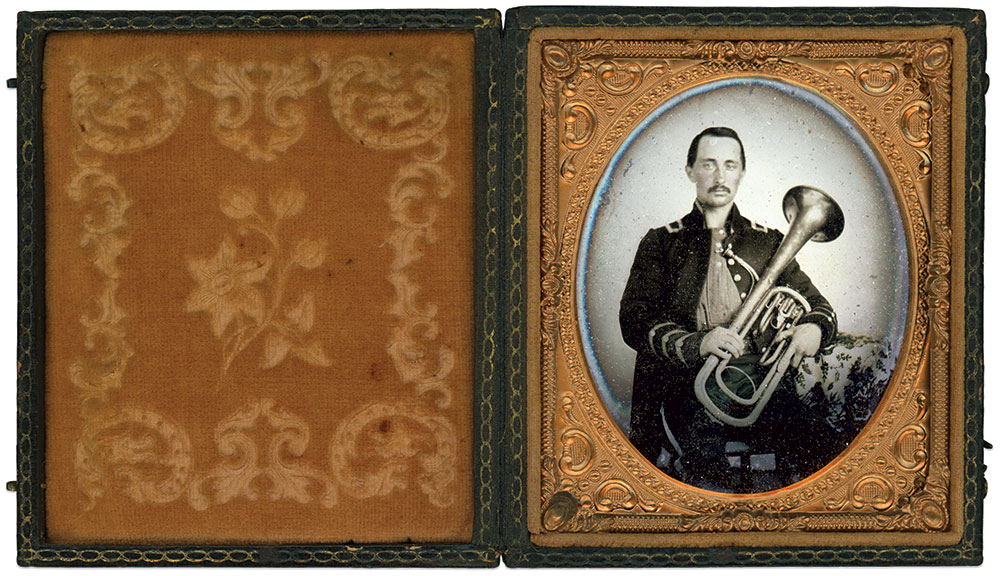
Sitting with his B-flat upright tenor horn with Berliner pumpen (piston) valves, top, this bandsman’s nonstandard uniform frock coat features cuffs with three broad stripes and buttons with matching collar trim and decorative shoulder straps. His instrument is probably French made.

A photograph album connected to the 4th Michigan Infantry included this portrait of a musician holding an E-flat over-the-shoulder soprano saxhorn probably made by John F. Stratton of New York City. Worthy of note is his cap with a number 4 in the center and a thick band, shoulder straps, non-standard waistbelt and holster with decorative flap.

A period pencil inscription on the back of the mount of this bandsman’s portrait identifies him as “O.R. Wine, Band, 1st Brigade, 3rd Division, 2nd Army Corps, Army of the Potomac” and “‘Sullivan’s Band,’ Troy NY.” He poses with an over-the-shoulder B-flat baritone saxhorn with Allen valves, by either D.C. Hall, or Hall & Quinby of Boston, Mass. His New York National Guard belt plate and the two-tone pompon on his cap were adopted in 1863 and worn through the 1870s, according to Anthony Gero, an MI Contributing Editor who featured this image in a 1995 story.
References to Sullivan’s Band of Troy suggest the group directed by John H.B. Sullivan enjoyed wide popularity from about 1860 into the 1870s. Its connection to the army’s 2nd Corps is mentioned in the Jan. 20, 1865, edition of the New York Daily Herald. According to a report dated three days earlier from the Petersburg front, the band performed for a review of the 3rd Division, led by Brig. Gen. Gershom Mott, for Maj. Gen. Andrew A. Humphreys, the commander of the 2nd Corps. “The Third Division band—formerly known as Sullivan’s Band, of Troy—in the meantime discoursing music in a manner to call forth the highest encomiums of all.”
The name O.R. Wine has yet to be traced. The photographer, Arthur Cobden, was active in Troy from about 1859 through the mid-1870s.

It is a reasonable bet that this cornet player holds a notebook filled with music. His B-flat side-action-rotary-valve orchestra model was made by John F. Stratton of New York City, a major manufacturer and merchandiser in the United States and Europe.

This musician displays an over-the-shoulder E-flat alto saxhorn with Berliner pumpen (piston) valves, an instrument of European manufacture, possibly for retailer Charles A. Zoebisch of New York City. He wears a shell jacket with a slit pocket—the contents inside are visible but not recognizable.

Though William Harrison Tripp started his military service in the 1st Wisconsin Cavalry as a bugler, he’s pictured here with what may be his instrument of choice: An over-the-shoulder E-flat alto saxhorn with Berliner pumpen (piston) valves of European manufacture. A native of Pennsylvania born to a German father and Keystone State mother, he had relocated to Wisconsin before the war.
The regiment spent its enlistment in numerous cavalry operations in Arkansas, Missouri, Tennessee, Kentucky, Alabama and Georgia. In the last-named state, a detachment of troopers from the 1st participated in the capture of Confederate President Jefferson Davis in May 1865.
Tripp was not part of the group of Wisconsin men who hunted Davis, for he had mustered out in September 1864 after his original three-year enlistment expired.
Tripp returned to Wisconsin and later moved to Missouri and became a farmer in Sedalia. He died in 1921 at age 85, and was survived by his wife and at least one child.

Samuel P. St. John of the 4th Michigan Cavalry band wears a four-button sack coat and holds an over-the-shoulder B-flat soprano saxhorn possibly made by John F. Stratton of New York City. Born in Michigan, he lived in Macomb County upon his enlistment in the summer of 1862. He remained a musician until November 1864, when he became the regiment’s quartermaster and served in this capacity until July 1865.
The Michiganders spent most of their time in uniform attached to the Army of the Cumberland and Cavalry Corps of the Military Division of Mississippi. They engaged in numerous operations, including the battles of Stones River and Chickamauga, and the Atlanta Campaign. A detachment of troopers from the regiment participated in the capture of Confederate President Jefferson Davis at Irwinville, Ga., on May 10, 1865. St. John returned to Macomb County after mustering out and died in 1894 at age 54. His wife, Emma, survived him.

This musician, dressed in a frock coat trimmed on the cuffs and collar, grips an E-flat upright-bell alto saxhorn with Berliner pumpen, a piston valve design that dates to the early 19th century.

The Tabor family of Darlington, Wis., had three boys who served in the Union army and survived the war. One of them, George W. Tabor, is pictured here with an over-the-shoulder B-flat bass saxhorn. Born in Canada to English subjects, he immigrated to America in 1856. Tabor did not enlist in the Union army until February 1865, during the war’s final months. He mustered out in September of that year and returned to Wisconsin.
Tabor eventually settled in Grand Rapids, Mich., where he worked in the lumber industry. He died at age 77 in 1919. His wife, Rosaltha, and two children survived.
A band member poses with an unmarked cap and a European-made over-the-shoulder B-flat baritone saxhorn with mechanical-linkage valves. His frock coat features a trimmed collar and decorative shoulder straps.

At first glance, this gent with a patterned vest and ornate watch fob with an over-the-shoulder B-flat bass saxhorn (large-bore baritone) with four valves does not appear military. His cap, marked with the hunting horn insignia of the infantry and the letters KCB suggest he served in a Union brigade band. His instrument was probably manufactured by Isaac Fiske of Worcester, Mass.


An E-flat circular cornet made by John F. Stratton of New York City is front and center in this musician’s portraits. Note the subtle differences in the position of his head and cornet. It is easy to imagine the photographer made these ambrotypes only minutes apart.

Morris E. Seeley handled two instruments with the 12th Wisconsin Infantry. One of them, pictured here, is an over-the-shoulder E-flat alto saxhorn by an indeterminate maker. The other, according to a post-war biography, was a musket. Seeley fought in the ranks of Company B during the Atlanta Campaign and elsewhere and earned his corporal’s chevrons for his courage.
Born in Ohio, Seeley had moved at about age five with his family to Reedsburg, a settlement of five log shanties near Native American villages. His biographer noted that when “in search of playmates the youth often chose as his boyhood friends the Indian youths of the locality.” During this period, he learned Indian words and recalled them throughout his life.
Seeley survived the war and returned to Reedsville, where he prospered as a carpenter, and repairer of lawnmowers and other machines. He was also known as an artist for his woodcarvings. Upon his death in 1921 at age 81, his only child, a daughter survived him. He outlived his wife, Nellie.
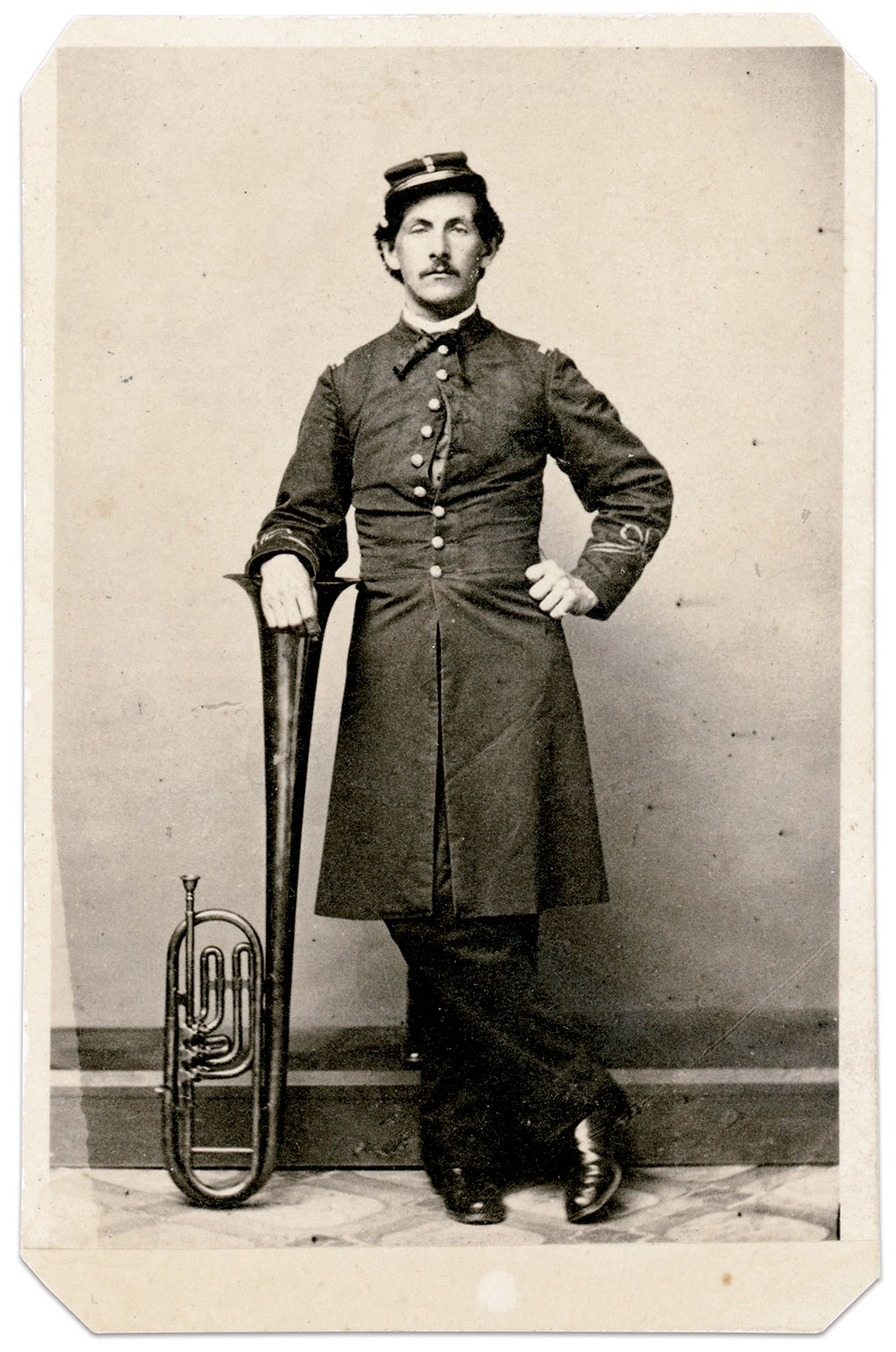
Pvt. Richard L. Knight of the 150th New York Infantry rests a forearm on the bell of his over-the-shoulder B-flat tenor saxhorn. Members of the regiment’s band were not designated as musicians but detailed from various companies. Knight was one of three enlisted men from Company F who received musical instruments instead of muskets. The 150th served in the Defenses of Baltimore from October 1862 to July 1863. His horn, made by Kummer & Schetelich of Baltimore, may have been purchased in the city. Knight remained in the army until June 1865 when the 150th mustered out of service. He lived until 1903, dying at about age 64.

It seems likely that the photographer who took this portrait of David L. Thomas removed studio accessories to make room for his horn. The instrument is an E-flat over-the-shoulder four-valve bass saxhorn, or tuba, probably made by J. Lathrop Allen, D.C. Hall, or Allen & Hall of Boston, Mass.
Thomas served with the 3rd Rhode Island Infantry band in the Defenses of New Orleans and elsewhere in Louisiana from February 1864 to August 1865. His military service record notes he was a prisoner of war for much of 1865. During this time, the regiment participated in various scouts and other expeditions into active war zones. He may have fallen into enemy hands during one of these operations. Thomas survived his service and lived until 1900, dying at about age 65.

Musician Robert J. Hancock of the 3rd Rhode Island Cavalry displays his E-flat over-the-shoulder soprano saxhorn by an indeterminate maker. Hancock joined the 3rd in the spring of 1864 and spent the next 20 months in the Defenses of New Orleans and elsewhere in Louisiana—an eyewitness to the closing scenes of the war in the Trans-Mississippi. Prior to his time as a trooper, he served a nine-month enlistment in the ranks of the 46th Massachusetts Infantry.
A Bay State native and resident, he returned home after the end of his service and worked as a toolmaker and in the railroad industry. He died in 1910 at about age 70. He outlived his first wife, Corlista, who is buried beside him in a Palmer, Mass., cemetery. His second wife, Fannie, survived him.
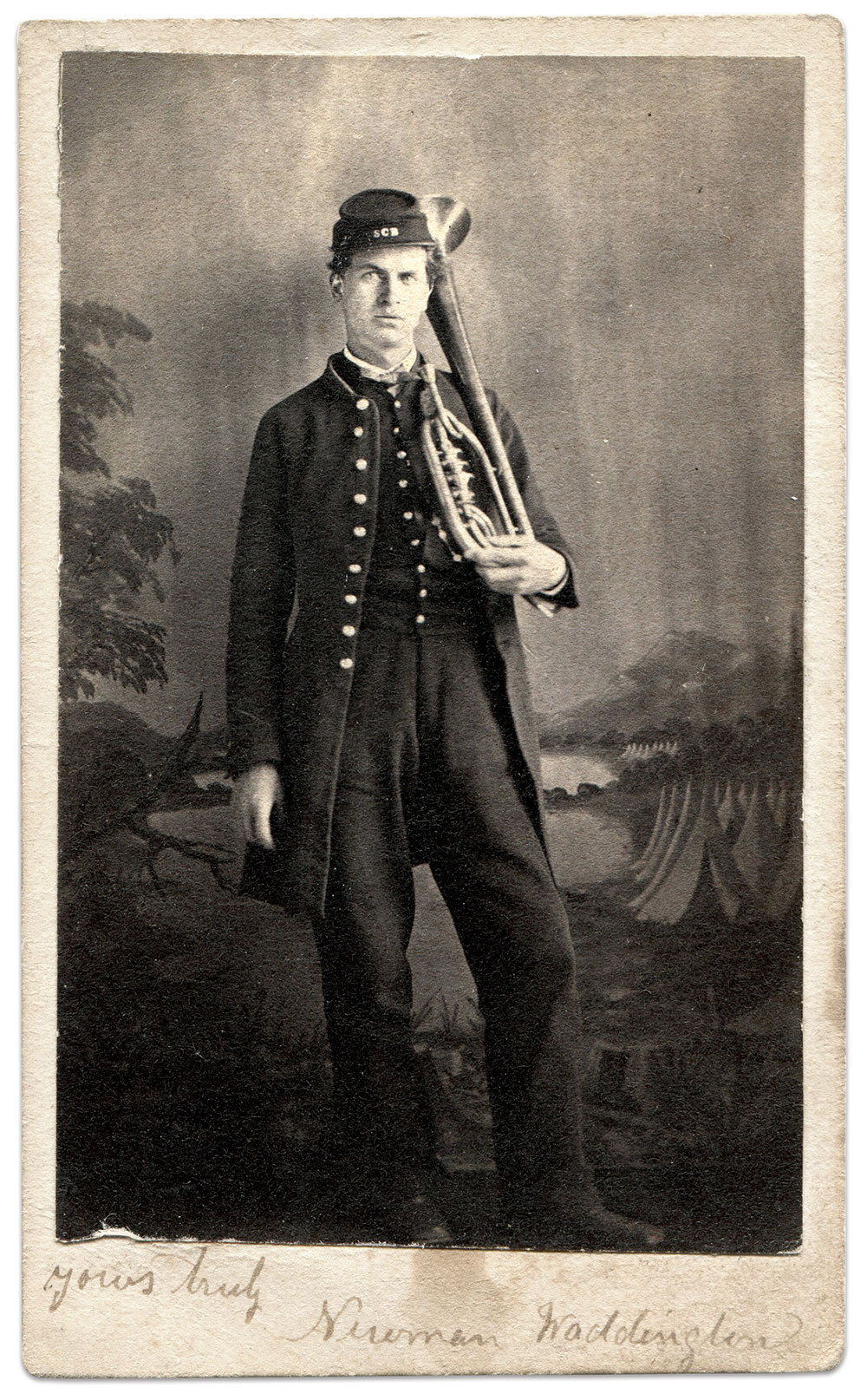
Newman Mitchell Waddington of New York was a boy of 15 when the war began. Drafted after he turned 18 in 1863, he joined the veteran 56th New York Infantry in South Carolina. He stands here with his over-the-shoulder E-flat alto saxhorn and wears a cap marked with the letters SCB—likely Sullivan County Band (one of the counties that supplied men to the regiment). He mustered out with his comrades in Company A at Charleston, S.C., in October 1865.
Waddington’s fragmentary post-war record places him in California in the 1870s and in a soldier’s home in Kingston, N.Y., in 1920, using the alias George M. Cole. Upon his death in 1925, his remains were buried and identified by his alias in Bath National Cemetery in Steuben County, N.Y.
General references: Stockham, Jeff. “Historic Instruments from Civil War Brass Bands,” Making Music; Library of Congress, “The Civil War Bands.”
SPREAD THE WORD: We encourage you to share this story on social media and elsewhere to educate and raise awareness. If you wish to use any image on this page for another purpose, please request permission.
LEARN MORE about Military Images, America’s only magazine dedicated to showcasing, interpreting and preserving Civil War portrait photography.
VISIT OUR STORE to subscribe, renew a subscription, and more.

